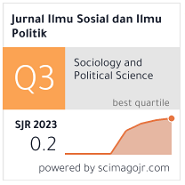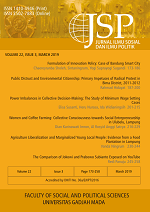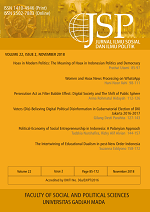Modelling E-Government Maturity Determinants at the Local Level in Indonesia Using Technology-Organization-Environment Framework
Torontuan Keban Yeremias(1), Dian Cahyadi(2*), Achmad Djunaedi(3)
(1) Department of Public Policy and Management, Faculty of Social and Political Sciences, Universitas Gadjah Mada, Indonesia
(2) The Graduate School of Universitas Gadjah Mada, Indonesia
(3) Department of Architecture and Planning Engineering, Faculty of Geography, Universitas Gadjah Mada, Indonesia
(*) Corresponding Author
Abstract
Local governments in Indonesia have adopted e-government, but the maturity has not met the expected target. The distribution of the achievement of the SPBE index (as a representation of e-government maturity in the context of Indonesia) with a bare minimum “Good” predicate centered on the island of Java raises questions regarding the determinants of success. Existing studies and models on the determinants of e-government maturity mainly focus on local governments in developed countries. This study aims to explore the determinants in the context of local government in developing countries by proposing a new model using the Technology- Organization-Environment (TOE) Framework and assessing the model. The model comprises eight determinants reflecting three variables: technology, organisation, and environment, which can influence the level of e-government maturity in Indonesia. The assessment applies the PLS- SEM multivariate analysis method involving 383 district/city governments in Indonesia in 2021. The results show that the proposed model has adequate validity and reliability, indicating that technology factors (technology and electricity infrastructure), organisational factors (innovative, finance and HR capacity), and environmental factors (human capital, human development, and community welfare) have a significant positive effect on e-government maturity. However, the assessment shows that the model quality measurement is only 31.9% accurate, which is considered weak. Model refinement by strengthening the organisational and environmental variables is needed, and fit-model testing is suggested for further research.
Keywords
Full Text:
PDFReferences
Adu, K. K., Dube, L., & Adjei, E. (2016). Digital Preservation: The Conduit Through Which Open Data, Electronic Government and The Right to Information are Implemented. Library Hi Tech, 34(4), 733–747. https://doi.org/10.1108/LHT-07-2016-0078
Alexopoulos, C., Diamantopoulou, V., Lachana, Z., Charalabidis, Y., Androutsopoulou, A., & Loutsaris, M. A. (2019). How Machine Learning is Changing E-Government. PervasiveHealth: Pervasive Computing Technologies for Healthcare, Part F1481 (5), 354–363. ht t ps:/ / doi. org/10.1145/3326365.3326412
Alryalat, M. A. A., Rana, N. P., Sahu, G. P., Dwivedi, Y. K., & Tajvidi, M. (2017). Use of Social Media in Citizen-Centric Electronic Government Services: A Literature Analysis. International Journal of Electronic Government Research, 13(3), 55–79. https:// doi.org/10.4018/IJEGR.2017070104
Alshibly, H., Chiong, R., & Bao, Y. (2016). Investigating the Critical Success Factors for Implementing Electronic Document Management Systems in Governments: Evidence From Jordan. Information Systems Management, 33(4), 287–301. https://doi.org/10.1080/10580530.2016.1220213
Anshari, M., & Lim, S. A. (2017). E-Government with Big Data Enabled through Smartphone for Public Services: Possibilities and Challenges. International Journal of Public Administration, 40(13), 1143–1158. https://doi.org/10.1080/01900692.2016.1242619
Awaludin, L. (2019). Strategi Penguatan Kompetensi SDM Teknologi Informasi & Komunikasi (TIK) dalam Mengoptimalkan Penerapan Sistem Pemerintahan Berbasis Elektronik (SPBE). Paradigma POLISTAAT Jurnal Ilmu Sosial Dan Ilmu Politik, 2(2),
118–134. https:/ /doi.org/ 10.23969/paradigmapolistaat.v2i2.2115
Badan Pusat Statistik. (n.d.). https://www.bps. go.id/subject/26/indeks-pembangunan- manusia.html#subjekViewTab1
Baker, J. (2012). The Technology–Organization– Environment Framework. In Springer (pp. 231–245). https://doi.org/10.1007/978-1-4419-6108-2_12
Budding, T., Faber, B., & Gradus, R. (2018). Assessing Electronic Service Delivery in Municipalities: Determinants and Financial Consequences of E-Government Implementation. Local Government Studies, 44(5), 697–718. https://doi.org/10.1080/03003930.2018.1473768
Das, A., Singh, H., & Joseph, D. (2017). A longitudinal study of e-government maturity. Information and Management, 54(4), 415–426. https://doi.org/10.1016/j.im.2016.09.006
Defitri, S. Y., Bahari, A., Handra, H., & Febrianto, R. (2020). Determinant factors of e-government implementation and public accountability: Toe framework approach. Public Policy and Administration, 19(4), 37–51. https://doi.org/10.13165/VPA-20-19-4-03
Edwards, G. C. (1980). Implementing public policy. Implementing Public Policy, 181.
Frías-Aceituno, J. V., García-Sánchez, I. M., & Rodríguez-Domínguez, L. (2014). Electronic administration styles and their determinants. Evidence from Spanish local governments. Transylvanian Review of Administrative Sciences, 41, 90 108.
Hair, J. F., Ringle, C. M., & Sarstedt, M. (2011). PLS-SEM: Indeed a silver bullet. Journal of Marketing Theory and Practice, 19(2), 139–152. https://doi.org/10.2753/MTP1069-6679190202
Hair, J., Hult, G. T., Ringle, C., & Sarstedt, M. (2017). A Primer on Partial Least Squares Structural Equation Modeling (PLS-SEM) - Joseph F. Hair, Jr., G . Tomas M. Hult, Christian Ringle, Marko Sarstedt. In Sage.
Hanum, S., Adawiyah, R. Al, Sensuse, D. I., Lusa, J. S., Arief, A., & Prima, P. (2020). Factors Influencing e-Government Adoption (A Case Study of Information System Adoption in PPATK) (Faktor-faktor yang Memengaruhi Adopsi e-Government (Studi Kasus Adopsi Sistem Informasi di PPATK)). JURNAL IPTEKKOM (Jurnal Ilmu Pengetahuan & Teknologi Informasi), 22(1), 19–30. https://jurnal.kominfo.go.id/index.php/iptekkom/article/view/2862
Henseler, J., Ringle, C. M., & Sarstedt, M. (2015). A new criterion for assessing discriminant validity in variance-based structural equation modeling. Journal of the Academy of Marketing Science, 43(1), 115–135. https://doi.org/10.1007/s11747-014-0403-8
Ifinedo, P. (2011). Factors influencing e-government maturity in transition economies and developing countries: A longitudinal perspective. Data Base for Advances in Information Systems, 42(4), 98–116. https://doi. org/10.1145/2096140.2096147
Indraswati, & Akram. (2019). Determinan Anggaran Berbasis Kinerja Terhadap E-Government : Pengujian Interaksi Money Follow Program. Akurasi: Jurnal Studi Akuntansi Dan Keuangan, 1(1), 43–62. https://doi.org/10.29303/akurasi.v1i1.4
Ingrams, A., Manoharan, A., Schmidthuber, L., & Holzer, M. (2020). Stages and Determinants of E-Government Development: A Twelve-Year Longitudinal Study of Global Cities. International Public Management Journal, 23(6), 731–769. https://doi.org/10.1080/10967494.2018.1467987
Krishnan, S., Teo, T. S. H., & Lim, J. (2013). E-participation and E-government maturity: A global perspective. IFIP Advances in Information and Communication Technology, 402, 420–435. https://doi.org/10.1007/978-3-642-38862-0_26
Krishnan, S., Teo, T. S. H., & Lymm, J. (2017). Determinants of Electronic Participation and Electronic Government Maturity: Insights from Cross-Country Data. International Journal of Information Management, 37(4), 297–312. https://doi. org/10.1016/j.ijinfomgt.2017.03.002
Larosiliere, G. D., & Carter, L. D. (2016a). Using a fit-viability approach to explore the determinants of e-government maturity. Journal of Computer Information Systems, 56(4), 271–279. https://doi.org/10.1080/08874417.2016.1163995
Larosiliere, G. D., & Carter, L. D. (2016b). Using a fit-viability approach to explore the determinants of e-government maturity. Journal of Computer Information Systems, 56(4), 271–279. https://doi.org/10.1080/08874417.2016.1163995
Lee, C. P., Chang, K., & Berry, F. S. (2011). Testing the Development and Diffusion of E-Government and E-Democracy: A Global Perspective. Public Administration Review , 71 (3), 444–454. https://doi.org/10.1111/j.1540-6210.2011.02228.x
Manoharan, A . (2013). A Study of the Determinants of County E-Government in the United States. American Review of Public Administration, 43(2), 159–178. https://doi.org/10.1177/0275074012437876
Manoharan, A. P., Zheng, Y., & Melitski, J. (2017). Global comparativ e municipal e-governance: factors and trends. International Review of Public Administration, 22(1), 14–31. https://doi.org/10.1080/12294659.2017.1292031
Milakovich, M. E. (2021). Digital governance: Applying advanced technologies to improve public service. In Digital Governance: Applying Advanced Technologies to Improve Public Service. Routledge. https://doi.org/10.4324/9781003215875
Nam, T. (2019). Does E-Government Raise Effectiveness And Efficiency? Examining The Cross-National Effect. Journal of Global Information Management, 27(3), 120–138. https://doi.org/10.4018/JGIM.2019070107
Ndiege, J. R. A. (2020). Promoting e-participation in County Governments: A case of a county government in a developing country. 2020 7th International Conference on EDemocracy and EGovernment, ICEDEG 2020, 275–278. https://doi.org/10.1109/ICEDEG48599.2020.9096756
Papadopoulou, P., Kolomvatsos, K., & Hadjiefthymiades, S. (2020). Internet of Things in E-Government. International Journal of Artificial Intelligence and Machine Learning, 10(2), 99–118. https://doi. org/10.4018/ijaiml.2020070106
Pudjianto, B., Zo, H., Ciganek, A. P., & Rho, J. J. (2011). Determinants of e-government assimilation in Indonesia : An empirical investigation using a TOE framework. Asia Pacific Journal of Information Systems, 21(1), 49–80. https://www.koreascience. or.kr/article/JAKO201117148817253.page
Rahmanto, A. N., & Dirgatama, C. H. A. (2018). The Implementation of E-Government through Social Media Use in Local Government of Solo Raya. 2018 International Conference on Information and Communications Technology, ICOIACT 2018, 2018-Janua(83), 765–768. https://doi. org/10.1109/ICOIACT.2018.8350763
Roy, J.P. (2019). Service, openness and engagement as digitally-based enablers of public value? A critical examination of digital government in Canada. International Journal of Public Administration in the Digital Age, 6(3), 23–40. https://doi.org/10.4018/IJPADA.2019070102
Sarstedt, M., Ringle, C. M., Smith, D., Reams, R., & Hair, J. F. (2014). Partial least squares structural equation modeling (PLS-SEM): A useful tool for family business researchers. Journal of Family Business Strategy, 5(1), 105–115. https:// doi.org/10.1016/j.jfbs.2014.01.002
Serrano-Cinca, C., Rueda-Tomás, M., & Portillo- Tarragona, P. (2009). Determinants of e-government extension. Online Information Review, 33(3), 476–498. https:// doi.org/10.1108/14684520910969916
Sharma, S. K. (2006). E-Government Services Framework. In Encyclopedia of E-Commerce, E-Government, and Mobile Commerce (pp. 373–378). IGI Global. https://doi. org/10.4018/978-1-59140-799-7.ch061
Singh, H., Das, A., & Joseph, D. (2007). Country-Level Determinants of E-Government Maturity. Communications of the Association for Information Systems, 20(March). https:// doi.org/10.17705/1cais.02040
Stier, S. (2015). Political determinants of e-government performance revisited: Comparing democracies and autocracies. Government Information Quarterly, 32(3), 270–278. https://doi.org/10.1016/j.giq.2015.05.004
Tornatzky, L. G., & Fleischer, M. (1990). The Processes of Technological Innovation. In D.C. Heath & Company (1st ed.). Lexington Books.
United Nations. (2003). UN Global E-Government Survey 2003 (1st ed.). United Nations- Department of Economic and Social Affairs.
United Nations. (2018). United Nations E-Government Survey 2018 (1st ed.). UN. ttps://doi.org/10.18356/d54b9179-en
United Nations. (2020). E-Government Survey 2020 - Digital Government in the Decade of Action for Sustainable Development: With Addendum on COVID-19 Response (1st ed.). United Nations-Department of Economic and Social Affairs. publicadministration. un.org
Article Metrics
Refbacks
- There are currently no refbacks.
Copyright (c) 2024 Jurnal Ilmu Sosial dan Ilmu Politik

This work is licensed under a Creative Commons Attribution-ShareAlike 4.0 International License.






















